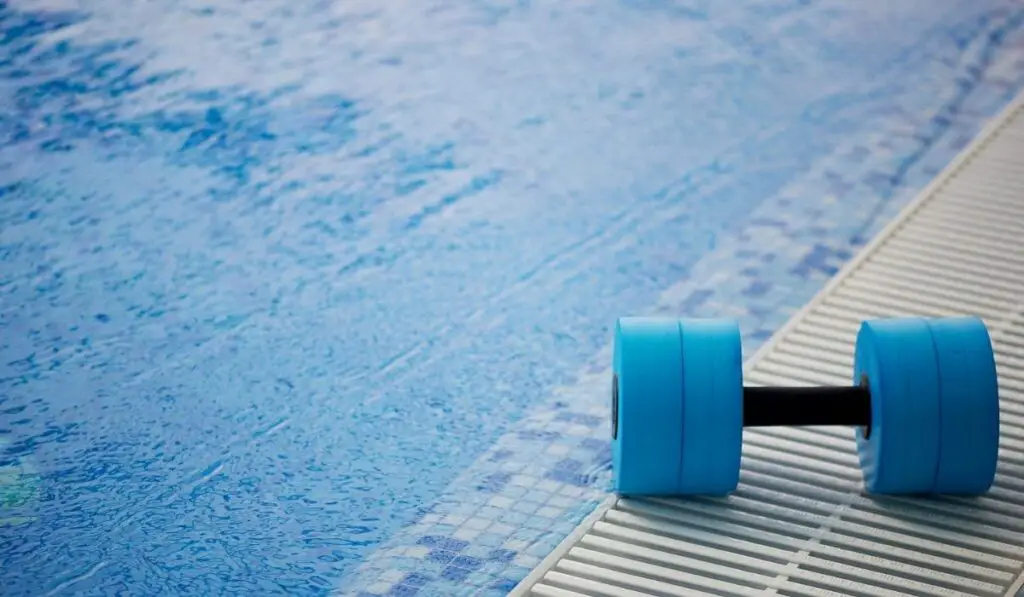Admit it: blue is a calming color that improves a pool’s aesthetic. It’s probably what makes the poolside a perfect relaxation spot! But, of course, now we all know that water in its natural state is clear, so what about swimming pools that make them appear blue?
There’s not question that pools look blue, but this isn’t actually because of the water. Clean, well-treated water is going to be clear. The blue is almost always from the blue paint or liner underneath the clear water. Some chemicals include blue dye, which increases this effect.
In this article, we’ll further explore this phenomenon and other reasons. We’ll also discuss why your swimming pools appear cloudy and what you can do about it.
What Makes Pool Water Appear Blue?

The most common misconception about why pools appear blue is that they are painted blue. While this is the case in some swimming pools, most modern pools use more natural and unique finishes.
For instance, some popular choices in swimming pool building materials are porcelain, stone, and glass; yet, the water in these pools is still blue. So what gives pools the blue color?
Light Interaction
The first theory, which is scientifically correct, is that the light interacts with water molecules to give it a blue hue. In this case, when the water molecules interact with light, they absorb the red light waves and reflect the blue light waves, which gives pool water its blue appearance.
The selection process between the two most dominant light waves is known as electromagnetic absorption. It is the primary reason water in swimming pools and other water bodies appear blue.
This explains why a very deep pool or the ocean takes on a blue color, but a pool that’s only 3-6 feet isn’t deep enough for this effect to really start stacking up. So, in shallower pools, the blue is from the liner or paint color, and it’s only in the deep end, or very deep pools, that also get some blue coloration from this light absorption effect.
Minerals
The mineral composition in the pool also affects the color of the swimming pool. This is because different minerals and the types of plants/microorganisms in the water tend to have specific properties that affect the reflection of light back upwards and towards the surface.
Since swimming pool water contains chlorine which kills most microorganisms, there’s little to inhibit the reflection of blue light.
Again, this is something that will technically make the pool bluer, but the effect is so minuscule as to basically be negligible considering the amount of blue that will be coming from the liner or paint job.
The Sky’s Reflection
One of the most common theories, which has been scientifically disproven to be a fact, is that the blue color comes from the sky’s reflection. Most people assume this to be true because the water in most bodies such as lakes, oceans, and seas also appears blue.
Although the theory makes some sense, indoor pools also appear blue and discredit this theory. Therefore, the color of the sky has little to do with the color of the water in the pool.
Why is Your Pool Water Bluish-Cloudy?
Something is reassuring and calming about a swimming pool with crystal clear water. It’s inviting and tempts you to jump right in and relax. But, on the other hand, a cloudy pool may cause slight discomfort in most people and discourage them from getting inside the pool since it looks dirty.
If you own a pool, the chances are that you’ve encountered a cloudy pool at least once or twice. Some of the reasons why your pool might be cloudy include:
Chemical Imbalance
A chemical imbalance in the swimming pool is usually the primary culprit in cloudy pools. It’s often caused by excess or insufficient chlorine or an imbalance in pH, alkalinity, calcium hardness, or stabilizer levels.
Ammonia and Algae Growth
Algae growth is widespread in the summer when most pools are opening up after not being used during winter. This is because FC and cyanuric acid levels drop to zero during winter, which may cause cloudiness that is difficult to clear.
Poor Filtration
A flawed filtration system may be caused by clogged or worn-out filter cartridges, which result in poor water circulation.
Environmental factors, debris, and mineral particles can also damage your filters. For example, dust, pollen, and leaves entering the swimming pool and building up in the filter can impede the cleaning process. Insects, bugs, and bird droppings that find their way into a swimming pool after heavy rains can also have the same effect.
Additionally, run-off water sometimes adds minerals that cause clouding in the pool, such as phosphates, silicate, and sulfates.
How to Deal with a Cloudy Pool

The first step to dealing with a cloudy pool is to use a test strip to know whether the chemical imbalance causes the cloudiness. Once you figure out the cause of cloudiness in your swimming pool, here’s what you should do:
- In case of debris and run-off, consider getting a pool cover and preventing debris from getting in.
- If your pool has too much ammonia, use more chlorine than you usually would.
You should also maintain your pool well, even during inactivity.
